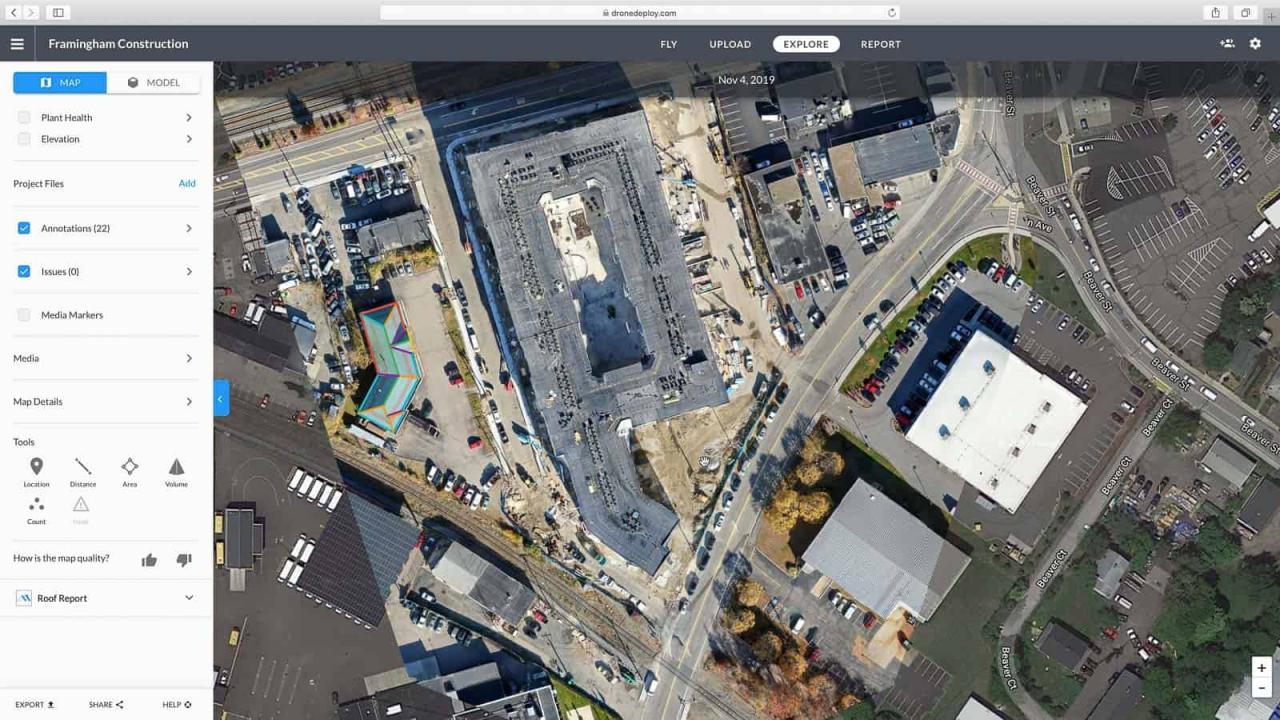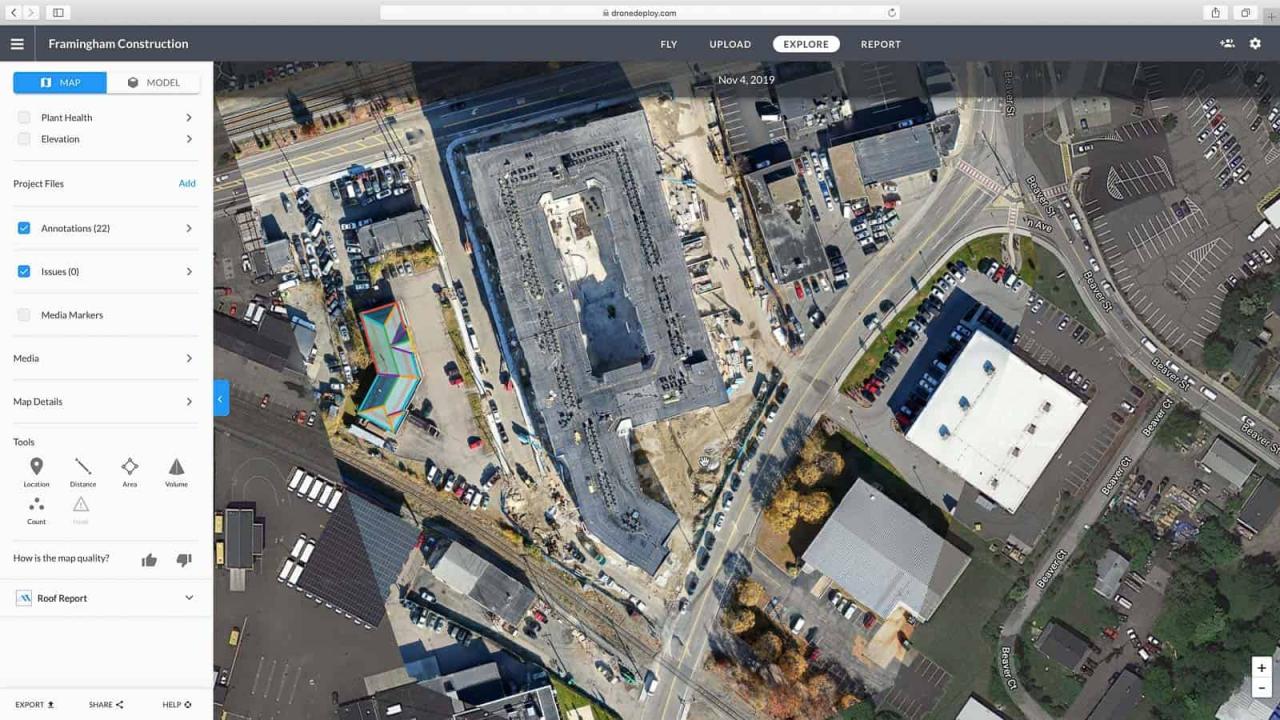How to use drone deploy – How to use DroneDeploy? This guide dives into the exciting world of drone data acquisition and analysis using the DroneDeploy platform. We’ll walk you through everything from setting up your account and planning flights to processing imagery and creating professional deliverables. Get ready to unlock the power of aerial data!
We’ll cover account creation, flight planning, data processing techniques, generating various map products (orthomosaics, point clouds, 3D models), and sharing your work with collaborators. We’ll also explore advanced features and troubleshoot common issues, ensuring you become proficient in utilizing DroneDeploy’s full capabilities.
Getting Started with DroneDeploy
DroneDeploy is a powerful cloud-based platform for planning, flying, and processing drone data. This section will guide you through the initial setup and data import process.
DroneDeploy Platform Functionalities
The DroneDeploy platform offers a comprehensive suite of tools for managing the entire drone workflow. Key functionalities include flight planning with automated mission creation, real-time flight monitoring, data processing for creating various deliverables (orthomosaics, 3D models, point clouds), and collaborative project sharing. It also offers advanced features like measurement tools, volume calculations, and integrations with other software.
Getting started with DroneDeploy is easier than you think! First, you’ll want to set up your account and connect your drone. Then, check out this awesome guide on how to use DroneDeploy for a step-by-step walkthrough. After that, you’ll be planning your flights and processing your data in no time, mastering the art of aerial imagery analysis with DroneDeploy.
Creating and Verifying a DroneDeploy Account
- Navigate to the DroneDeploy website and click “Sign Up”.
- Enter your email address, create a password, and select your account type (individual or organization).
- Complete the registration form with necessary information.
- Check your email inbox for a verification link and click it to activate your account.
Importing Drone Flight Data
- Log in to your DroneDeploy account.
- Click on “Import Data”.
- Select the data source (e.g., SD card, cloud storage). The supported formats will vary depending on your drone model.
- Select the flight data files you wish to import.
- DroneDeploy will process the data and create a new project. This may take some time depending on the data size and processing options selected.
Organizing Projects in DroneDeploy
Effective project organization is crucial for efficient workflow. Use descriptive project names and create folders to categorize your projects based on clients, locations, or project types. This ensures easy retrieval and prevents confusion.
Planning and Executing Flights
This section details the process of planning and executing autonomous drone flights using DroneDeploy.
Designing a Flight Plan
DroneDeploy’s planning tools allow you to create efficient flight paths. Key considerations include setting the correct altitude to achieve the desired ground sampling distance (GSD), defining appropriate overlap between images (typically 70-80% sidelap and 60-70% frontlap for optimal data processing), and selecting the appropriate camera settings (e.g., ISO, shutter speed) based on lighting conditions. The software will automatically calculate the flight time and battery requirements.
Connecting Your Drone to DroneDeploy
The process of connecting your drone varies depending on the drone model. Generally, you’ll need to download the DroneDeploy mobile app and follow the in-app instructions to pair your drone with your account. This usually involves enabling Bluetooth or WiFi connectivity on your drone and confirming the connection within the app. DroneDeploy supports a wide range of drone models.
Pre-Flight Checks
Before initiating a flight, the DroneDeploy app will prompt you to perform essential pre-flight checks. These typically include verifying GPS signal strength, confirming battery levels, and checking for any potential obstacles in the flight area. Always carefully review these checks to ensure a safe and successful flight.
Potential Flight Issues and Solutions
- GPS Signal Loss: Ensure a clear view of the sky and relocate to an area with stronger GPS reception if necessary.
- Low Battery: Always start with a fully charged battery and monitor battery levels throughout the flight. Land the drone immediately if the battery level gets too low.
- Obstructions: Carefully plan your flight path to avoid any obstacles, and use DroneDeploy’s obstacle avoidance features if available.
Processing and Analyzing Data
Once your flight is complete, DroneDeploy will automatically begin processing the data. This section explains the available options and their effects.
Drone Imagery Processing
After uploading your flight data, DroneDeploy automatically initiates the processing. This involves stitching together the individual images to create a seamless orthomosaic, generating a 3D model (point cloud), and performing georeferencing. The processing time depends on several factors, including the size of the area covered, image resolution, and processing options selected.
Processing Options and Data Quality
DroneDeploy offers different processing options to optimize for speed or accuracy. Higher-quality processing settings result in better image clarity and accuracy but take longer to complete. Faster processing may sacrifice some detail, but it’s often suitable for quick preliminary assessments.
Comparison of Data Processing Methods
The choice of processing method depends on the specific project requirements and the acceptable trade-off between processing time and data quality. For critical projects requiring high accuracy, a longer processing time is often acceptable.
| Processing Method | Processing Time (Estimate) | Data Size (Estimate) | Image Quality |
|---|---|---|---|
| Standard | 15-30 minutes (small area) | 1-5 GB | Good |
| High Accuracy | 1-3 hours (small area) | 5-15 GB | Excellent |
| Ultra High Resolution | 3-8 hours (small area) | 15-50 GB | Exceptional |
| Fast Processing | 5-15 minutes (small area) | 0.5-2 GB | Fair |
Creating Deliverables and Sharing Data: How To Use Drone Deploy
This section focuses on generating various map products from processed data and sharing them with collaborators.
Generating Map Products

Once the processing is complete, DroneDeploy allows you to generate various deliverables. These include orthomosaics (2D maps), point clouds (3D point data), and 3D models. You can adjust settings such as resolution and color correction to optimize the output for your needs.
Exporting Data
DroneDeploy supports various data export formats including GeoTIFF, KMZ, and others. The choice of format depends on the intended use of the data and compatibility with other software. GeoTIFF is a common format for georeferenced raster data, while KMZ is a zipped KML file suitable for use in Google Earth.
Sharing Projects and Data
DroneDeploy makes it easy to share projects and data with collaborators. You can invite users to view or edit projects, controlling their access permissions. This fosters seamless collaboration on projects.
Creating a Professional Report
To create a professional report, utilize the data generated by DroneDeploy. Integrate images, measurements, and analysis into your report using a word processing or presentation software. Highlight key findings and insights derived from the data.
Key Finding 1: The orthomosaic clearly shows the extent of the damage caused by the recent storm.
Key Finding 2: Volume calculations indicate approximately 150 cubic meters of material need to be removed.
Advanced DroneDeploy Features

DroneDeploy offers a range of advanced features to enhance your workflow and data analysis.
Automated Measurements and Volume Calculations
DroneDeploy’s automated measurement tools allow you to easily measure distances, areas, and volumes directly on the processed data. This eliminates the need for manual calculations, saving significant time and effort. These measurements are accurate and reliable, provided the data processing was performed correctly.
Software Integrations
DroneDeploy integrates with various other software and platforms, enhancing its functionality and streamlining workflows. These integrations may include GIS software, CAD programs, and cloud storage services, allowing seamless data exchange and analysis.
Getting started with DroneDeploy is easier than you think! First, you’ll want to familiarize yourself with the flight planning tools. Then, check out this awesome tutorial on how to use DroneDeploy to master data processing and analysis. Finally, practice makes perfect – so get out there and start flying!
Subscription Tiers and Features
DroneDeploy offers various subscription tiers, each with different features and pricing. Choosing the right tier depends on your usage needs and budget. Higher tiers generally offer increased storage, processing capabilities, and advanced features.
- Basic: Limited storage, basic processing features.
- Plus: Increased storage, access to advanced processing options.
- Enterprise: Highest storage capacity, full access to all features, dedicated support.
Troubleshooting and Support
This section addresses common issues and provides solutions, along with guidance on accessing support resources.
Common Errors and Solutions

- Data Processing Errors: Check the processing logs for error messages and consult DroneDeploy’s support documentation for troubleshooting steps. Issues may be related to insufficient overlap, poor image quality, or corrupted data files.
- Drone Connectivity Problems: Ensure your drone’s firmware is up to date, check for interference from other devices, and verify proper Bluetooth or WiFi connectivity. Restarting both your drone and mobile device can also resolve connection issues.
- Account Login Issues: Check your email for password reset instructions or contact DroneDeploy support if you’re experiencing persistent login problems.
Accessing Support Resources, How to use drone deploy
DroneDeploy offers comprehensive support resources, including online documentation, tutorials, and a dedicated support team. Their website usually contains a help center with FAQs and articles addressing common issues. Contact their support team for more complex problems or technical assistance.
Troubleshooting Drone Connectivity
A flowchart would be helpful here, but I can’t create visual elements. The troubleshooting steps would generally involve checking the drone’s battery level, confirming proper WiFi/Bluetooth pairing, ensuring a clear signal, restarting the drone and mobile device, and verifying compatibility between the drone and DroneDeploy app.
Mastering DroneDeploy empowers you to capture, process, and analyze aerial data efficiently. From planning autonomous flights to generating insightful reports, you’ve learned the essential steps to leverage this powerful platform. Now go forth and explore the possibilities of aerial data acquisition and analysis!
Essential FAQs
Can I use DroneDeploy with any drone?
DroneDeploy supports a wide range of drones, but compatibility varies. Check the DroneDeploy website for a list of supported models.
What kind of internet connection do I need?
A stable internet connection is crucial for uploading and processing data. A strong Wi-Fi connection or cellular data with sufficient bandwidth is recommended.
How much does DroneDeploy cost?
DroneDeploy offers various subscription plans with different features and pricing. Visit their website for the most up-to-date pricing information.
What file formats can I export?
DroneDeploy supports various export formats, including GeoTIFF, KMZ, and others. The specific options depend on the type of data and your chosen processing settings.
